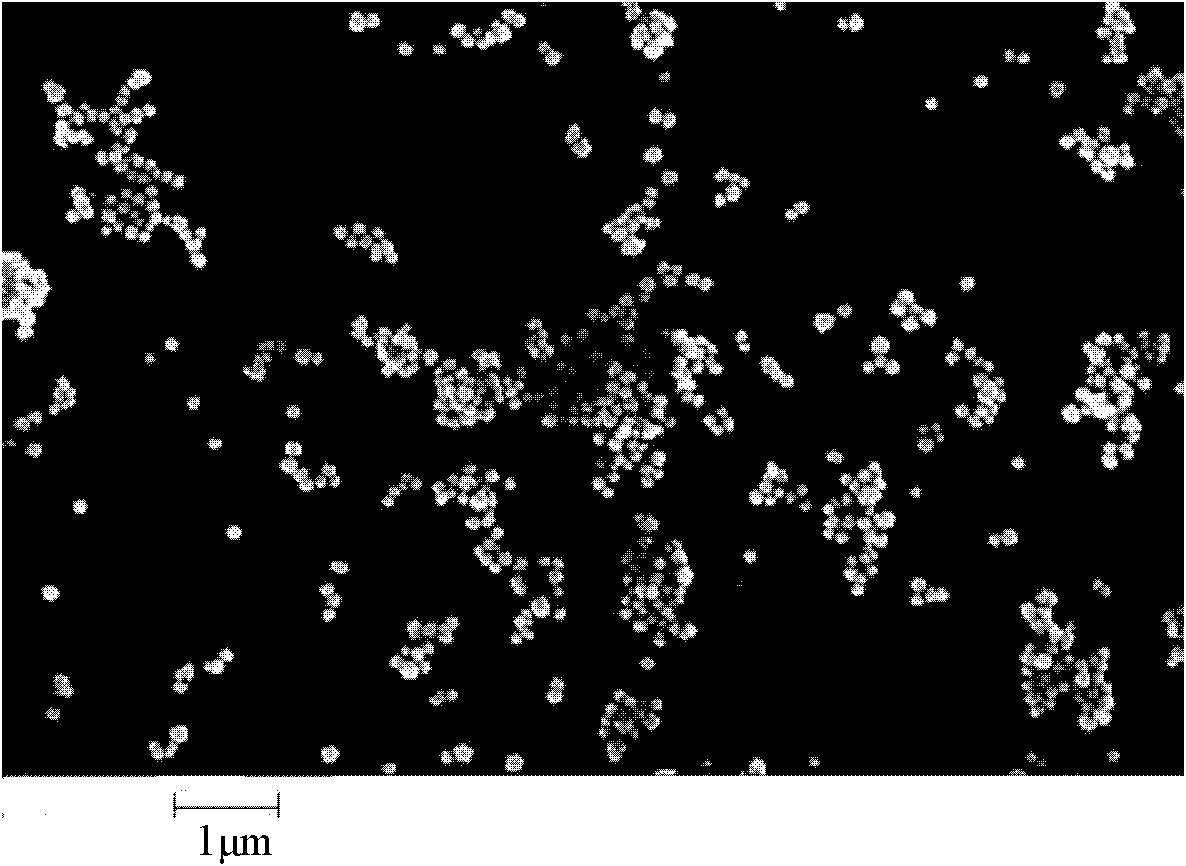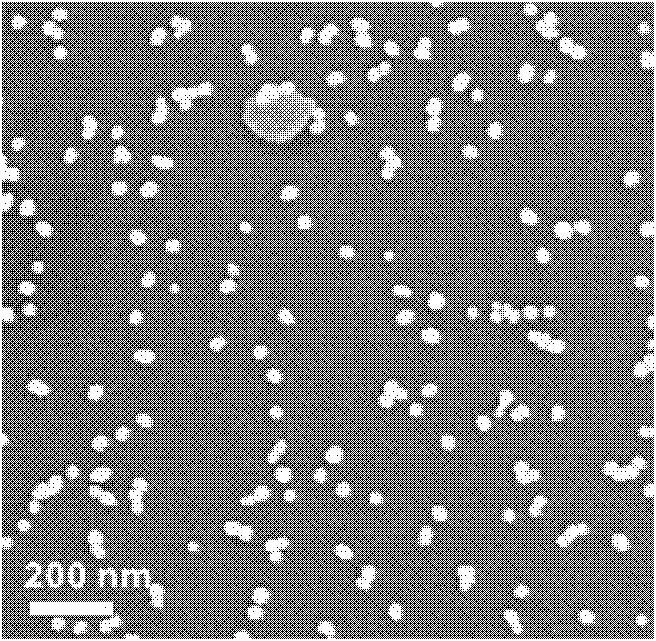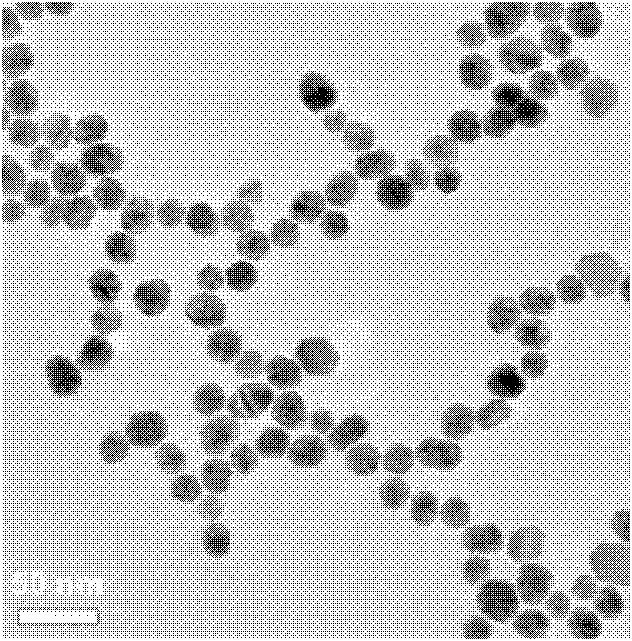Method for detecting biomolecule by using Fe3O4@Au nucleocapsid nano-probe
A technology of biomolecules and nanoprobes, applied in the direction of material excitation analysis, Raman scattering, etc., can solve the problems of low chemical stability and easy oxidation, achieve good chemical stability and biocompatibility, and improve efficiency , Simple and quick operation
- Summary
- Abstract
- Description
- Claims
- Application Information
AI Technical Summary
Problems solved by technology
Method used
Image
Examples
Embodiment 1
[0034] 1) Fe 3 o 4 Preparation of Au probe: First, it can be prepared according to the method disclosed in Chinese patent CN101773810A, the specific method is as follows:
[0035] (1) Preparation of iron ferric oxide nanoparticles: weigh 0.26g FeSO 4 ·7H 2 O dissolved in 2.5ml 2M / L KNO 3 Add 2.5ml of 1M / L NaOH solution to the solution, stir, add 20ml of 1-5g / L PEI solution with a molecular weight of (1,800-25,000), put it into a microwave reactor at 90°C, and react for 30-120min. After the reaction, the magnetic separation was washed 5 times with deionized water, dispersed in 25ml water and preserved, and the final gained solution ferric oxide content concentration was 0.012M (mass ratio of FeSO 4 ·7H 2 O: KNO 3 :NaOH=1.87:10:5).
[0036] (2) Preparation of 2.6nm gold nanoparticles: refer to the method [Brown, K.R.; Walter, D.G.; Natan, M.J.Chem.Mater.2000, 12(2), 306-313.] method, the specific steps are, take 1ml 1%HAucl 4 The solution was dropped into 90 ml of ultra...
Embodiment 2
[0042] 1) Fe 3 o 4 Preparation of Au probe: First, it can be prepared according to the method disclosed in Chinese patent CN101773810A, the specific method is as follows:
[0043] (1) Preparation of iron ferric oxide nanoparticles: weigh 0.26g FeSO 4 ·7H 2 O dissolved in 2.5ml 2M / L KNO 3 Add 2.5ml of 1M / L NaOH solution to the solution, stir, add 20ml of 1-5g / L PEI solution with a molecular weight of (1,800-25,000), put it into a microwave reactor at 90°C, and react for 30-120min. After the reaction, the magnetic separation was washed 5 times with deionized water, dispersed in 25ml water and preserved, and the final gained solution ferric oxide content concentration was 0.012M (mass ratio of FeSO 4 ·7H 2 O: KNO 3 :NaOH=1.87:10:5).
[0044] (2) Preparation of 2.6nm gold nanoparticles: with reference to the method of literature (Brown, K.R.; Walter, D.G.; Natan, M.J.Chem.Mater.2000, 12(2), 306-313), the specific steps are to measure 1ml 1 %HAuCl 4 The solution was droppe...
Embodiment 3
[0050] 1) Fe 3 o 4 Preparation of Au probe: First, it can be prepared according to the method disclosed in Chinese patent CN101773810A, the specific method is as follows:
[0051] (1) Preparation of iron ferric oxide nanoparticles: weigh 0.26g FeSO 4 ·7H 2 O dissolved in 2.5ml 2M / L KNO 3 Add 2.5ml of 1M / L NaOH solution to the solution, stir, add 20ml of 1-5g / L PEI solution with a molecular weight of (1,800-25,000), put it into a microwave reactor at 90°C, and react for 30-120min. After the reaction, the magnetic separation was washed 5 times with deionized water, dispersed in 25ml water and preserved, and the final gained solution ferric oxide content concentration was 0.012M (mass ratio of FeSO 4 ·7H 2 O: KNO 3 :NaOH=1.87:10:5).
[0052] (2) Preparation of 2.6nm gold nanoparticles: refer to the method [Brown, K.R.; Walter, D.G.; Natan, M.J.Chem.Mater.2000, 12(2), 306-313.] method, the specific steps are, take 1ml 1%HAuCl 4 The solution was dropped into 90 ml of ultra...
PUM
| Property | Measurement | Unit |
|---|---|---|
| particle diameter | aaaaa | aaaaa |
| diameter | aaaaa | aaaaa |
| diameter | aaaaa | aaaaa |
Abstract
Description
Claims
Application Information
 Login to View More
Login to View More - R&D
- Intellectual Property
- Life Sciences
- Materials
- Tech Scout
- Unparalleled Data Quality
- Higher Quality Content
- 60% Fewer Hallucinations
Browse by: Latest US Patents, China's latest patents, Technical Efficacy Thesaurus, Application Domain, Technology Topic, Popular Technical Reports.
© 2025 PatSnap. All rights reserved.Legal|Privacy policy|Modern Slavery Act Transparency Statement|Sitemap|About US| Contact US: help@patsnap.com



